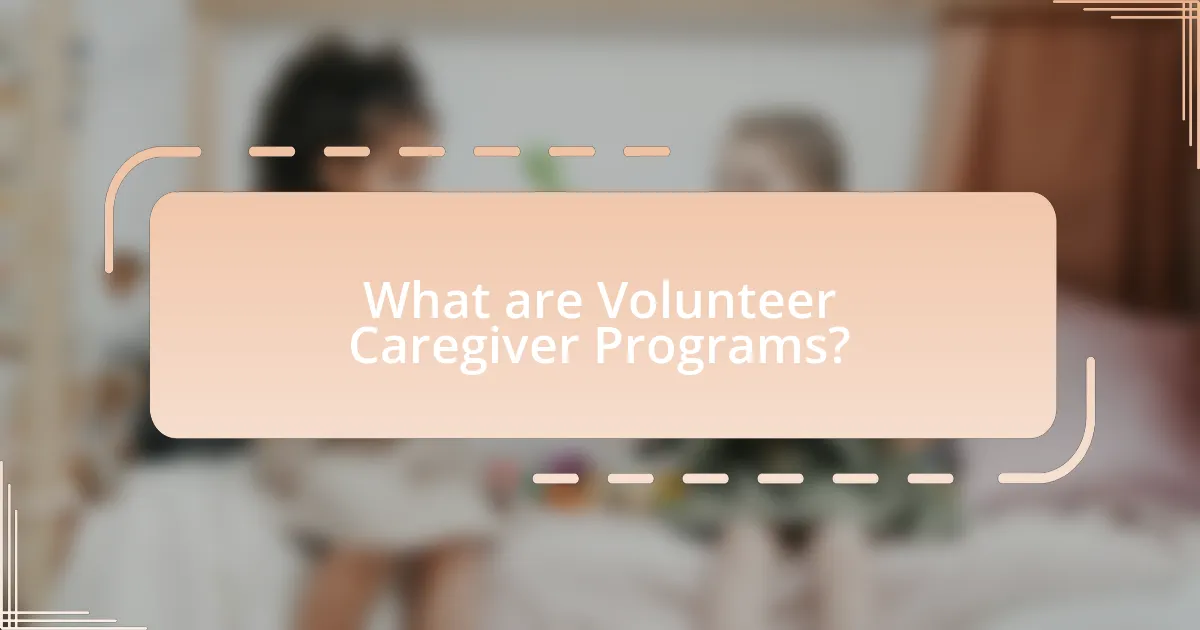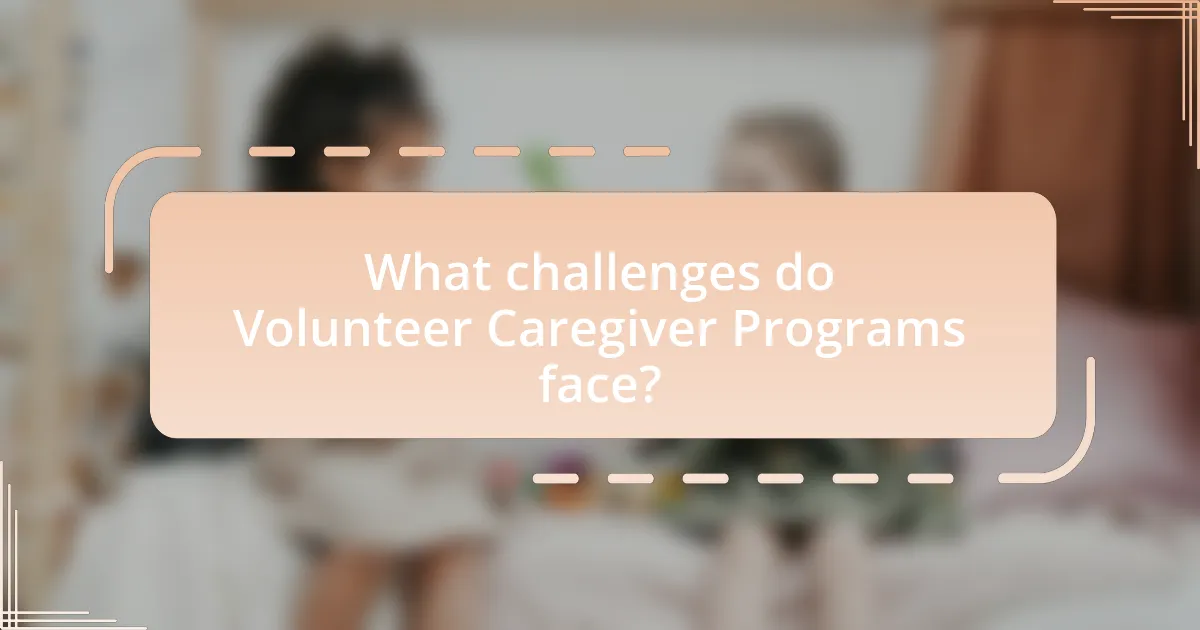Volunteer caregiver programs are initiatives designed to connect volunteers with individuals requiring assistance, primarily the elderly and those with disabilities. These programs enhance the quality of life for recipients through companionship, personal care, and support with daily activities, while also fostering community engagement and social connections among volunteers. The article explores the functioning of these programs within communities, the roles of volunteer caregivers, recruitment and training processes, and the significant impact on social cohesion and the well-being of vulnerable populations. Additionally, it addresses challenges faced by these programs, effective strategies for recruitment and retention, and best practices for measuring their impact and ensuring sustainability.

What are Volunteer Caregiver Programs?
Volunteer caregiver programs are initiatives that connect volunteers with individuals in need of assistance, typically the elderly or those with disabilities. These programs aim to provide support through companionship, personal care, and help with daily activities, thereby enhancing the quality of life for recipients. Research indicates that such programs not only benefit the individuals receiving care but also foster community engagement and social connections among volunteers, contributing to stronger community ties.
How do Volunteer Caregiver Programs function within communities?
Volunteer caregiver programs function within communities by mobilizing individuals to provide essential support and assistance to those in need, such as the elderly, disabled, or chronically ill. These programs typically recruit and train volunteers who then engage in various activities, including companionship, transportation, meal preparation, and personal care, thereby enhancing the quality of life for recipients. Research indicates that such programs not only alleviate the burden on formal healthcare systems but also foster social connections and community cohesion, as evidenced by a study from the National Council on Aging, which found that volunteer caregiving significantly improves both the mental and physical health of caregivers and care recipients alike.
What roles do volunteer caregivers typically fulfill?
Volunteer caregivers typically fulfill roles that include providing companionship, assisting with daily living activities, and offering emotional support. These caregivers help individuals with tasks such as meal preparation, transportation, and medication reminders, which enhances the quality of life for those they assist. Research indicates that volunteer caregivers significantly reduce feelings of isolation among recipients, thereby fostering stronger community ties and improving overall well-being.
How are volunteer caregivers recruited and trained?
Volunteer caregivers are recruited through community outreach initiatives, partnerships with local organizations, and targeted advertising campaigns. These methods help identify individuals who are compassionate and willing to dedicate their time to support others. Training for volunteer caregivers typically involves structured programs that include orientation sessions, skill-building workshops, and ongoing support from experienced staff. For instance, organizations often provide training on communication skills, caregiving techniques, and understanding the needs of those they will assist. This comprehensive approach ensures that caregivers are well-prepared to provide effective support, enhancing the overall quality of care within the community.
Why are Volunteer Caregiver Programs important for community building?
Volunteer Caregiver Programs are important for community building because they foster social connections and support networks among residents. These programs enable individuals to engage in caregiving roles, which not only assists those in need but also strengthens relationships within the community. Research indicates that communities with active volunteer programs experience increased social cohesion, as participants report higher levels of trust and collaboration. For instance, a study by the Corporation for National and Community Service found that volunteering leads to improved community engagement and a sense of belonging, which are critical components of a strong community.
What impact do these programs have on social cohesion?
Volunteer caregiver programs significantly enhance social cohesion by fostering connections among community members. These programs create opportunities for individuals to engage with one another, share experiences, and build trust, which are essential components of a cohesive society. Research indicates that communities with active volunteer programs report higher levels of social interaction and support, leading to a stronger sense of belonging and collective identity. For instance, a study by the Corporation for National and Community Service found that volunteering increases social ties and civic engagement, which are critical for maintaining social cohesion.
How do they address the needs of vulnerable populations?
Volunteer caregiver programs address the needs of vulnerable populations by providing essential support services tailored to their specific challenges. These programs often include assistance with daily living activities, companionship, and emotional support, which are critical for individuals facing health issues, disabilities, or social isolation. Research indicates that such programs can significantly improve the quality of life for participants; for instance, a study published in the Journal of Community Health found that individuals receiving volunteer caregiver support reported a 30% increase in overall well-being. By mobilizing community resources and fostering connections, these programs effectively enhance the resilience and stability of vulnerable groups.

What are the key benefits of Volunteer Caregiver Programs?
Volunteer Caregiver Programs provide essential support to individuals in need, enhancing community well-being. These programs improve the quality of life for recipients by offering companionship, assistance with daily activities, and emotional support, which can lead to reduced feelings of isolation and depression. Research indicates that communities with active volunteer caregiver initiatives experience stronger social ties and increased civic engagement, fostering a sense of belonging among residents. Additionally, these programs can alleviate the burden on family caregivers, allowing them to maintain their own well-being while ensuring their loved ones receive necessary care.
How do these programs enhance community health and well-being?
Volunteer caregiver programs enhance community health and well-being by providing essential support services that improve access to care and foster social connections. These programs facilitate assistance with daily activities, such as meal preparation and transportation, which can significantly reduce isolation among vulnerable populations, including the elderly and disabled. Research indicates that social engagement and support can lead to better mental health outcomes, as evidenced by a study published in the Journal of Community Health, which found that individuals receiving volunteer support reported lower levels of depression and anxiety. Furthermore, these programs promote community cohesion by encouraging volunteerism, which strengthens social ties and builds a sense of belonging, ultimately contributing to a healthier community overall.
What specific health outcomes are associated with volunteer caregiving?
Volunteer caregiving is associated with several specific health outcomes, including improved mental health, reduced depression, and enhanced physical well-being among caregivers. Research indicates that individuals who engage in volunteer caregiving often experience lower levels of stress and anxiety, which can lead to better overall mental health. For instance, a study published in the Journal of Health and Social Behavior found that volunteer caregivers reported higher life satisfaction and lower depressive symptoms compared to non-volunteers. Additionally, volunteering can promote physical activity, contributing to better cardiovascular health and overall fitness, as caregivers often engage in physically demanding tasks. These health benefits underscore the positive impact of volunteer caregiving on both the caregivers and the communities they serve.
How do these programs reduce isolation among community members?
Volunteer caregiver programs reduce isolation among community members by fostering social connections and providing support networks. These programs facilitate regular interactions between caregivers and those in need, which helps to build relationships and a sense of belonging. Research indicates that social engagement through such programs can significantly decrease feelings of loneliness; for instance, a study published in the Journal of Community Psychology found that participants in volunteer programs reported a 30% increase in social interactions and a corresponding decrease in isolation. By creating opportunities for community members to connect, share experiences, and support one another, these programs effectively combat social isolation.
What skills do volunteers gain through participation in caregiver programs?
Volunteers gain essential skills such as communication, empathy, and problem-solving through participation in caregiver programs. These programs require volunteers to interact with individuals in need, enhancing their ability to convey information clearly and compassionately. Additionally, volunteers learn to assess situations and make quick decisions, which fosters critical thinking and adaptability. Research indicates that volunteers in caregiver roles report increased emotional intelligence and interpersonal skills, which are vital for effective caregiving and community support.
How does volunteering improve personal development and employability?
Volunteering enhances personal development and employability by fostering essential skills and experiences that are highly valued in the job market. Engaging in volunteer work allows individuals to develop competencies such as teamwork, communication, and problem-solving, which are critical for professional success. For instance, a study by the Corporation for National and Community Service found that volunteers are 27% more likely to find a job after being out of work compared to non-volunteers, highlighting the direct correlation between volunteering and improved employability. Additionally, volunteering provides networking opportunities and real-world experience, making candidates more attractive to potential employers.
What training opportunities are available for volunteers?
Training opportunities for volunteers in caregiver programs typically include workshops, online courses, and hands-on training sessions. These programs often cover essential skills such as communication, first aid, and caregiving techniques. For example, organizations may offer certified training in CPR and basic health care, which equips volunteers with critical life-saving skills. Additionally, many programs provide mentorship from experienced caregivers, enhancing the learning experience through practical guidance. These structured training opportunities ensure that volunteers are well-prepared to support their communities effectively.

What challenges do Volunteer Caregiver Programs face?
Volunteer Caregiver Programs face several significant challenges, including recruitment and retention of volunteers, funding limitations, and training inadequacies. Recruitment and retention are critical as many programs struggle to attract and keep committed volunteers, which can lead to service gaps. According to a study by the National Volunteer Organizations, nearly 50% of volunteers discontinue their service within the first year due to burnout or lack of support. Funding limitations hinder the ability to provide adequate resources and support for both caregivers and the individuals they assist, often resulting in reduced program effectiveness. Additionally, training inadequacies can lead to volunteers feeling unprepared for the responsibilities they undertake, which can compromise the quality of care provided. These challenges collectively impact the sustainability and effectiveness of Volunteer Caregiver Programs.
What are common barriers to participation in these programs?
Common barriers to participation in volunteer caregiver programs include lack of time, insufficient awareness of the programs, and transportation challenges. Many potential volunteers have busy schedules that prevent them from committing to regular participation, as indicated by a survey from the Corporation for National and Community Service, which found that 40% of respondents cited time constraints as a primary reason for not volunteering. Additionally, a lack of knowledge about available programs can deter individuals from getting involved, as highlighted by research from the National Volunteer Center, which reported that 30% of people were unaware of local volunteer opportunities. Transportation issues also play a significant role, particularly for those in rural areas, where access to reliable transport can limit participation.
How can organizations overcome recruitment challenges?
Organizations can overcome recruitment challenges by implementing targeted outreach strategies and enhancing their employer branding. Targeted outreach involves identifying specific demographics and communities that align with the organization’s mission, which can increase the likelihood of attracting suitable candidates. For instance, organizations can utilize social media platforms and local community events to connect with potential volunteers who share similar values. Enhancing employer branding through testimonials and showcasing the impact of volunteer work can also attract individuals who are motivated by purpose-driven roles. Research indicates that organizations with strong employer brands can reduce recruitment costs by up to 50% and improve retention rates, demonstrating the effectiveness of these strategies in overcoming recruitment challenges.
What strategies can be implemented to retain volunteers?
To retain volunteers, organizations should implement strategies such as providing recognition, offering training opportunities, and fostering a sense of community. Recognition, such as awards or public acknowledgment, enhances volunteers’ motivation and commitment, as evidenced by a study from the Corporation for National and Community Service, which found that volunteers who feel appreciated are more likely to continue their service. Offering training opportunities not only equips volunteers with necessary skills but also increases their engagement; research indicates that volunteers who receive training are 50% more likely to stay involved. Lastly, fostering a sense of community through regular social events and team-building activities strengthens relationships among volunteers, leading to higher retention rates, as shown in various volunteer management studies.
How do funding and resources affect the sustainability of these programs?
Funding and resources are critical to the sustainability of volunteer caregiver programs, as they directly influence operational capacity and program longevity. Adequate funding allows these programs to recruit, train, and retain volunteers, ensuring that they can meet community needs effectively. For instance, a study by the National Council on Aging found that programs with stable funding sources are 50% more likely to maintain their services over time compared to those reliant on sporadic donations. Additionally, resources such as training materials and administrative support enhance the quality of care provided, which in turn fosters community trust and engagement. Therefore, the availability of consistent funding and resources is essential for the ongoing success and impact of volunteer caregiver programs.
What are effective fundraising strategies for caregiver programs?
Effective fundraising strategies for caregiver programs include leveraging community partnerships, hosting fundraising events, and utilizing online crowdfunding platforms. Community partnerships can enhance visibility and provide access to a broader donor base, as organizations often collaborate with local businesses and nonprofits to co-host events or campaigns. Fundraising events, such as charity walks or benefit dinners, not only raise funds but also engage the community and raise awareness about caregiver needs. Online crowdfunding platforms, like GoFundMe or Kickstarter, allow for reaching a wider audience and can be particularly effective in sharing personal stories that resonate with potential donors. According to a report by the National Council of Nonprofits, organizations that engage in diverse fundraising strategies tend to see a 30% increase in overall donations.
How can partnerships enhance resource availability?
Partnerships enhance resource availability by pooling together diverse assets, skills, and networks from multiple organizations or individuals. This collaborative approach allows for a more efficient allocation of resources, as partners can share funding, expertise, and facilities, thereby increasing the overall capacity to meet community needs. For instance, a study by the Stanford Social Innovation Review highlights that partnerships can lead to a 30% increase in resource efficiency by leveraging complementary strengths among partners. This synergy not only maximizes the impact of available resources but also fosters innovation and sustainability in community programs.
What best practices can enhance the effectiveness of Volunteer Caregiver Programs?
To enhance the effectiveness of Volunteer Caregiver Programs, implementing structured training and support systems for volunteers is essential. Research indicates that well-trained volunteers are more confident and effective in their caregiving roles, leading to improved outcomes for care recipients. For instance, a study published in the Journal of Gerontological Social Work found that training programs significantly increased volunteer retention rates and satisfaction levels, which are critical for the sustainability of these programs. Additionally, establishing clear communication channels between volunteers, caregivers, and program coordinators fosters collaboration and ensures that volunteers feel supported and valued, further enhancing program effectiveness.
How can organizations measure the impact of their programs?
Organizations can measure the impact of their programs through a combination of quantitative and qualitative metrics. Quantitative metrics include tracking participation rates, service delivery statistics, and outcome measurements such as improvements in community health indicators or participant satisfaction scores. Qualitative metrics involve gathering feedback through surveys, interviews, and focus groups to assess the perceived value and effectiveness of the programs. For example, a study by the Corporation for National and Community Service found that volunteer programs significantly improved community engagement and individual well-being, providing concrete evidence of their positive impact.
What are the key elements of successful volunteer training programs?
Successful volunteer training programs incorporate clear objectives, comprehensive orientation, ongoing support, and evaluation mechanisms. Clear objectives ensure that volunteers understand their roles and the impact of their contributions, which is essential for motivation and engagement. Comprehensive orientation provides volunteers with necessary information about the organization, its mission, and specific tasks, fostering confidence and competence. Ongoing support, including mentorship and regular check-ins, helps volunteers navigate challenges and enhances retention rates. Evaluation mechanisms, such as feedback surveys and performance assessments, allow organizations to measure effectiveness and make necessary adjustments, ensuring continuous improvement. Research indicates that programs with these elements see higher volunteer satisfaction and retention, ultimately leading to more effective community service outcomes.
What are practical steps for starting a Volunteer Caregiver Program?
To start a Volunteer Caregiver Program, first, identify the community needs by conducting surveys or focus groups to understand the specific caregiving requirements. Next, recruit volunteers through outreach efforts such as local events, social media campaigns, and partnerships with community organizations. After recruitment, provide comprehensive training that covers caregiving skills, safety protocols, and emotional support techniques to ensure volunteers are well-prepared. Establish a clear structure for the program, including roles, responsibilities, and communication channels, to facilitate effective coordination. Finally, implement a system for ongoing support and recognition of volunteers to maintain engagement and motivation. These steps are essential for creating a sustainable and impactful Volunteer Caregiver Program that meets community needs.